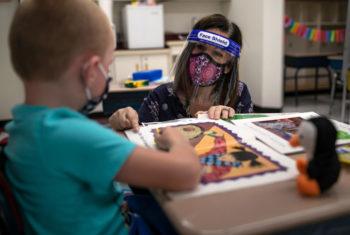Teachers Are Leaving The Classroom, But The Pandemic Is Not Yet To Blame

The pandemic disrupted the daily operations of schools across the country, but is not responsible for teachers leaving the classroom — so far, at least — according to a Texas A&M University expert on teacher success and retention.
Nationwide, about 6 percent of teachers and 6 percent of principals left at the end of the 2020-21 school year, said Andrew Kwok, an assistant professor in the Department of Teaching, Learning & Culture. This is in line with attrition rates before the pandemic.
“Pandemic-related issues might cause teachers to leave, but it’s too soon to tell right now,” Kwok said. “What we do know for sure is that the current teacher shortage largely is associated with academic subject and geographic location.”

The teacher shortage began years before the pandemic and continues today, Kwok said.
“The greatest ongoing need is for special education teachers, with 71% of districts reporting shortages, and substitute teachers are the second-greatest need,” Kwok said.
The other areas with the most shortages are science, technology, engineering and math (STEM) disciplines and bilingual education.
In addition, rural and urban schools tend to have more teacher turnover. About 65% of rural districts and 75% of urban districts report teacher shortages.
“Rural and inner-city schools often get teachers with less experience and less preparation, and who are more likely to get overwhelmed in the classroom and receive limited support and then leave,” Kwok said. “They get replaced by other inexperienced teachers, creating a persistent cycle of attrition.”
Kwok said that the extent of any pandemic-related issues that cause more teachers to leave will be known in the next year or two.
The main issue Kwok sees is teacher stress is over their health and safety and that of their students.
“Students being away from school created considerable academic, behavioral, social and emotional gaps,” he said.
In addition, Kwok said teachers are often pressured by their administration to maintain pre-pandemic academic standards even though the students are behind where they should be and may not even know “how to do” school.
Another major issue is the abrupt introduction of technology that changed how and where teaching and learning occur.
“Dealing with the technology needed to teach in a hybrid or remote situation can be extremely burdensome for both teacher and students,” Kwok said. “It’s no surprise that teachers experience exhaustion and mental or emotional burnout, and this might cause some to eventually leave.”
Kwok said there are concrete steps that school districts and training programs could take to attract and retain teachers, regardless of when or why teachers leave the profession.
“First, signing bonuses, higher salaries and financial incentives are crucial given the profession’s historically low salaries,” he said, adding that he recommends that schools use COVID-19 relief monies for this purpose. “Schools also could provide mentoring and workshops to help new teachers understand their students and how to more effectively teach them.”
Teacher training programs also have a role in ensuring that the expectations of new teachers align with the realities of the classroom.
“Universities should focus on providing the best possible training for preservice teachers — those getting their first experience in the classroom before becoming fully certified teachers,” he said. “Preservice teachers need to understand what the classroom is like and what is required of them, and ideally be placed in the locations where they want to end up.”
Similarly, Kwok said the mentor teachers and field supervisors responsible for preservice teachers’ smooth transition into the workplace should be better prepared to provide support, such as by helping teachers understand the diverse cultures their students represent and the importance of developing relationships with their students.
“This would involve shifting away from the outdated courses and curriculum often found in teacher training programs to emphasize the demands of today’s diverse classrooms,” he said.
In addition, Kwok recommended that school districts and universities work together to identify prospective teachers who are a good match for specific schools, and to bring these candidates to the schools much earlier in their training.
The bottom line, Kwok said, is that teachers who are a good fit for their school and have support, especially during their first years in the classroom, are more likely to stay, despite pandemics or other disruptions.
“The teacher shortage has not gotten worse in recent years, and districts and programs alike must do everything they can to ensure that this continues to be the case,” he said.
Media contact: Ann Kellett, akellett@tamu.edu




